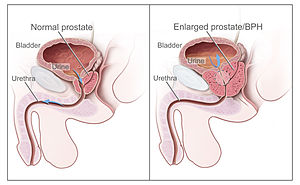Enlarged prostate
| Benign prostatic hyperplasia | |
|---|---|
| Synonyms | Benign enlargement of the prostate (BEP, BPE), adenofibromyomatous hyperplasia, benign prostatic hypertrophy, benign prostatic obstruction |
 |
|
| Diagram of a normal prostate (left) and benign prostatic hyperplasia (right). | |
| Specialty | Urology |
| Symptoms | Frequent urination, trouble starting to urinate, weak stream, inability to urinate, loss of bladder control |
| Complications | Urinary tract infections, bladder stones, chronic kidney problems |
| Usual onset | Age over 40 |
| Causes | Unclear |
| Risk factors | Family history, obesity, type 2 diabetes, not enough exercise, erectile dysfunction |
| Diagnostic method | Based on symptoms and examination after ruling out other possible causes |
| Similar conditions | Heart failure, diabetes, prostate cancer |
| Treatment | Lifestyle changes, medications, a number of procedures, surgery |
| Medication | Alpha blockers such as terazosin, 5α-reductase inhibitors such as finasteride |
| Frequency | 105 million affected globally (2015) |
| Classification |
· ·
|
|---|---|
| External resources |
Benign prostatic hyperplasia (BPH), also called prostate enlargement, is a noncancerous increase in size of the prostate. Symptoms may include frequent urination, trouble starting to urinate, weak stream, inability to urinate, or loss of bladder control. Complications can include urinary tract infections, bladder stones, and chronic kidney problems.
The cause is unclear. Risk factors include a family history, obesity, type 2 diabetes, not enough exercise, and erectile dysfunction. Medications like pseudoephedrine, anticholinergics, and calcium channel blockers may worsen symptoms. The underlying mechanism involves the prostate pressing on the urethra. Diagnosis is typically based on symptoms and examination after ruling out other possible causes.
Treatment options including lifestyle changes, medications, a number of procedures, and surgery. In those with mild symptoms weight loss, exercise, and decreasing caffeine intake is recommended. In those with more significant symptoms medications may include alpha blockers such as terazosin or 5α-reductase inhibitors such as finasteride. Surgical removal of part of the prostate may be carried out in those who do not improve with other measures. Alternative medicine such as saw palmetto do not appear to help.
About 105 million people are affected globally. BPH typically begins after the age of 40. Half of males age 50 and over are affected. After the age of 80 about 90% of males are affected. Although prostate specific antigen levels may be elevated in males with BPH, the condition does not increase the risk of cancer.
...
Wikipedia
